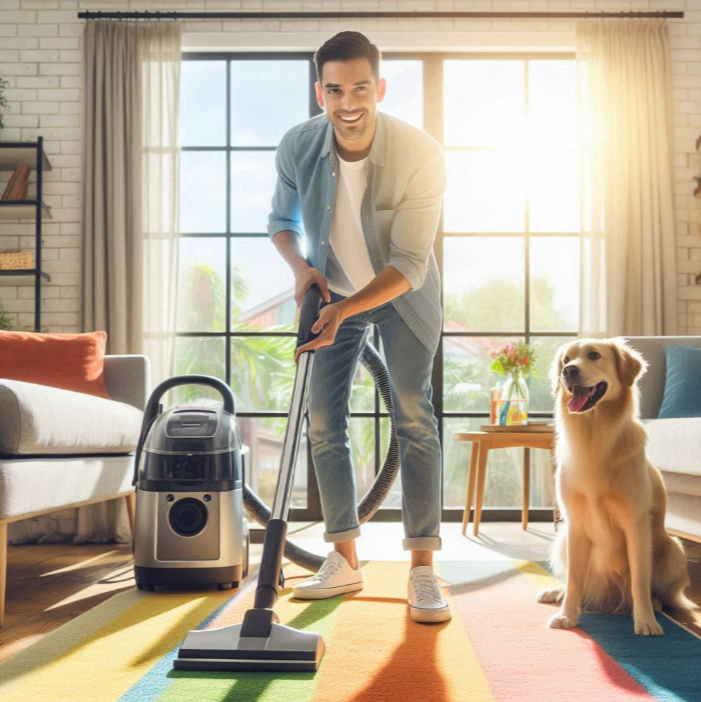Introduction
Your carpet is one of the most used—and abused—items in your home. Whether it’s kids, pets, or the occasional coffee spill, carpets can take a beating. And while vacuuming helps keep dirt and debris at bay, stubborn stains are a whole different story.
From red wine and pet accidents to ink and grease, some carpet stains just won’t budge easily. But don’t worry—this comprehensive guide will walk you through everything you need to know about removing even the most persistent carpet stains. By the end, you’ll have a spotless floor that looks as good as new.
Chapter 1: Understanding Your Carpet
Before diving into stain removal techniques, it’s important to understand what you’re working with.
1.1 Types of Carpet Fibers
Different carpet fibers react differently to stains and cleaning agents.
- Nylon: Durable and stain-resistant.
- Polyester: Resists water-based stains but not oil-based ones.
- Wool: Natural and luxurious, but sensitive to harsh chemicals.
- Olefin (Polypropylene): Resistant to moisture and mildew but difficult to clean if stained with oil.
1.2 Common Types of Carpet Stains
Understanding the nature of a stain helps you choose the best removal strategy.
- Water-Soluble Stains: Soda, wine, coffee, milk.
- Oil-Based Stains: Grease, makeup, lotion.
- Protein-Based Stains: Blood, vomit, urine.
- Dye Stains: Ink, food coloring.
- Combination Stains: Most real-life stains are a mix of the above.

Chapter 2: General Stain Removal Rules
Before attacking any stain, follow these golden rules:
2.1 Act Fast
The quicker you act, the better your chances of completely removing the stain.
2.2 Blot, Don’t Rub
Use a clean cloth or paper towel to blot—rubbing spreads the stain and damages fibers.
2.3 Test First
Always test your cleaning solution on an inconspicuous spot to avoid discoloration.
2.4 Use Cold Water First
Hot water can set some stains, particularly protein-based ones like blood or milk.
Chapter 3: DIY Stain Removal Methods
Professional cleaning isn’t always necessary. Here are proven DIY methods using items you likely already have.
3.1 White Vinegar and Baking Soda
- Blot the stain to remove excess.
- Sprinkle baking soda over the area.
- Mix equal parts water and white vinegar in a spray bottle and spray on the baking soda.
- Let sit for 5–10 minutes, then blot and vacuum.
3.2 Dish Soap Solution
- Mix a few drops of mild dish soap with warm water.
- Use a sponge to dab onto the stain.
- Blot with a clean towel and repeat until clean.
3.3 Hydrogen Peroxide for Tough Stains
Great for blood, wine, and juice stains.
- Mix 1 part hydrogen peroxide with 1 part water.
- Apply and let sit for 10 minutes.
- Blot and repeat as needed.
- Note: Test first! It may bleach some carpets.
3.4 Club Soda for Fresh Spills
- Pour a small amount of club soda directly onto the stain.
- Blot with a cloth.
- Repeat if necessary and dry with a towel.
Chapter 4: Specific Stain Solutions
Let’s tackle common stubborn stains with precision.
4.1 How to Remove Red Wine Stains
- Blot up as much wine as possible.
- Pour cold water to dilute.
- Use a mixture of 1 tbsp dish soap, 1 tbsp white vinegar, and 2 cups warm water.
- Blot until the stain lifts.
4.2 How to Remove Coffee Stains
- Blot immediately with a dry towel.
- Mix 1 tbsp dish soap, 1 tbsp white vinegar, and 2 cups warm water.
- Blot repeatedly.
- Use hydrogen peroxide if necessary for older stains.
4.3 How to Remove Pet Urine
- Blot as much urine as possible.
- Spray a mixture of equal parts vinegar and water.
- Sprinkle baking soda and let dry.
- Vacuum the residue.
- Use an enzymatic cleaner to remove odor.
4.4 How to Remove Ink Stains
- Dab (don’t rub!) with isopropyl alcohol on a cotton swab.
- Continue blotting with a clean cloth until the ink lifts.
- Rinse with water and dry.
4.5 How to Remove Grease and Oil
- Sprinkle cornstarch or baking soda to absorb grease.
- Let sit for 15 minutes, then vacuum.
- Use a few drops of dish detergent in warm water.
- Dab and blot until clean.
4.6 How to Remove Blood Stains
- Always use cold water.
- Blot the stain and apply a mixture of dish soap and water.
- For stubborn stains, try hydrogen peroxide.
Chapter 5: When DIY Isn’t Enough
There are times when professional help is necessary.
5.1 Deep-Set Stains
If the stain has soaked into the carpet padding, DIY methods may only mask the surface.
5.2 Specialty Carpets
Wool and silk carpets often require expert care to avoid damage.
5.3 Repeated Staining
If the same spot keeps getting dirty, it might need deep cleaning or replacement.
Chapter 6: Preventing Future Stains
Prevention is often the best cleaning strategy.
6.1 Use Rugs and Runners
Protect high-traffic areas with rugs and runners.
6.2 Implement a “No Shoes” Policy
Keep dirt and debris from entering your home.
6.3 Clean Spills Immediately
Quick response reduces the chance of permanent stains.
6.4 Apply Carpet Protectant
Scotchgard and similar products repel spills and dirt.
Chapter 7: Carpet Cleaning Tools and Products
Professional cleaners rely on these essential tools:
7.1 Carpet Cleaner Machines
Great for deep cleaning, especially for pet owners.
7.2 Steam Cleaners
Use hot water vapor to lift dirt and kill bacteria.
7.3 Enzymatic Cleaners
Best for organic stains like food, vomit, or urine.
7.4 Oxygen-Based Stain Removers
Use oxygen bleach (not chlorine) for stubborn stains.
7.5 Microfiber Cloths and Sponges
Gentle yet effective tools for blotting and scrubbing.
Chapter 8: Eco-Friendly Carpet Cleaning
Green cleaning methods help your home and the planet.
8.1 Natural Ingredients
- White vinegar
- Baking soda
- Lemon juice
- Essential oils
8.2 Eco-Friendly Brands
Look for brands certified by Green Seal or EcoLogo.
8.3 Avoid Harsh Chemicals
Ammonia and bleach can damage your carpet and pose health risks.
Chapter 9: A Weekly Carpet Maintenance Routine
Professional cleaners maintain spotless carpets by sticking to a schedule:
Weekly
- Vacuum thoroughly (twice per week in high-traffic areas).
- Spot-clean new stains immediately.
- Air out the room to reduce moisture.
Monthly
- Use a carpet powder to neutralize odors.
- Inspect for signs of wear or fading.
Every 6 Months
- Deep clean with a carpet shampooer or hire a professional.
Chapter 10: Final Tips for Carpet Longevity
A little care goes a long way.
- Rotate rugs to balance wear.
- Trim loose carpet fibers.
- Don’t over-wet your carpet during cleaning.
- Use doormats inside and outside entrances.
Conclusion
Banish Stubborn Stains: Stubborn carpet stains are no match for the right techniques and tools. With fast action, proven cleaning solutions, and a preventative mindset, you can keep your carpets looking new year after year.
Whether you’re dealing with muddy paw prints, spilled coffee, or a surprise from your toddler, this guide equips you with the knowledge and confidence to tackle any stain head-on.
Happy cleaning!
